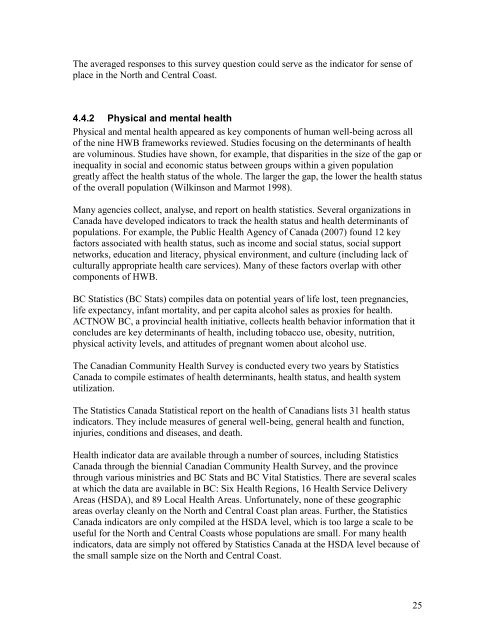Final report - Integrated Land Management Bureau
Final report - Integrated Land Management Bureau
Final report - Integrated Land Management Bureau
You also want an ePaper? Increase the reach of your titles
YUMPU automatically turns print PDFs into web optimized ePapers that Google loves.
The averaged responses to this survey question could serve as the indicator for sense of<br />
place in the North and Central Coast.<br />
4.4.2 Physical and mental health<br />
Physical and mental health appeared as key components of human well-being across all<br />
of the nine HWB frameworks reviewed. Studies focusing on the determinants of health<br />
are voluminous. Studies have shown, for example, that disparities in the size of the gap or<br />
inequality in social and economic status between groups within a given population<br />
greatly affect the health status of the whole. The larger the gap, the lower the health status<br />
of the overall population (Wilkinson and Marmot 1998).<br />
Many agencies collect, analyse, and <strong>report</strong> on health statistics. Several organizations in<br />
Canada have developed indicators to track the health status and health determinants of<br />
populations. For example, the Public Health Agency of Canada (2007) found 12 key<br />
factors associated with health status, such as income and social status, social support<br />
networks, education and literacy, physical environment, and culture (including lack of<br />
culturally appropriate health care services). Many of these factors overlap with other<br />
components of HWB.<br />
BC Statistics (BC Stats) compiles data on potential years of life lost, teen pregnancies,<br />
life expectancy, infant mortality, and per capita alcohol sales as proxies for health.<br />
ACTNOW BC, a provincial health initiative, collects health behavior information that it<br />
concludes are key determinants of health, including tobacco use, obesity, nutrition,<br />
physical activity levels, and attitudes of pregnant women about alcohol use.<br />
The Canadian Community Health Survey is conducted every two years by Statistics<br />
Canada to compile estimates of health determinants, health status, and health system<br />
utilization.<br />
The Statistics Canada Statistical <strong>report</strong> on the health of Canadians lists 31 health status<br />
indicators. They include measures of general well-being, general health and function,<br />
injuries, conditions and diseases, and death.<br />
Health indicator data are available through a number of sources, including Statistics<br />
Canada through the biennial Canadian Community Health Survey, and the province<br />
through various ministries and BC Stats and BC Vital Statistics. There are several scales<br />
at which the data are available in BC: Six Health Regions, 16 Health Service Delivery<br />
Areas (HSDA), and 89 Local Health Areas. Unfortunately, none of these geographic<br />
areas overlay cleanly on the North and Central Coast plan areas. Further, the Statistics<br />
Canada indicators are only compiled at the HSDA level, which is too large a scale to be<br />
useful for the North and Central Coasts whose populations are small. For many health<br />
indicators, data are simply not offered by Statistics Canada at the HSDA level because of<br />
the small sample size on the North and Central Coast.<br />
25
















